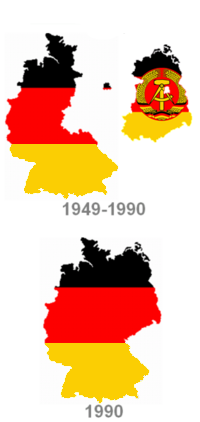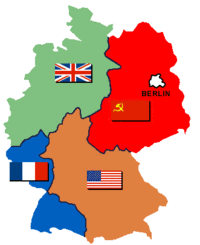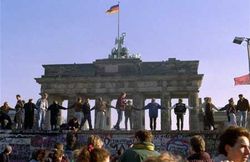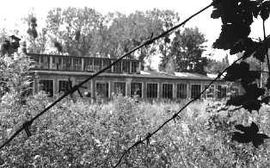German reunification
2007 Schools Wikipedia Selection. Related subjects: Recent History
German reunification (Deutsche Wiedervereinigung) took place on October 3, 1990, when the areas of the former German Democratic Republic (GDR, in English commonly called "East Germany") were incorporated into the Federal Republic of Germany (FRG, in English commonly called "West Germany").
After the GDR's first free elections on 18 March 1990, negotiations between the GDR and FRG culminated in a Unification Treaty, whilst negotiations between the GDR and FRG and the four occupying powers produced the so-called " Two Plus Four Treaty" granting full independence to a unified German state.
The reunified Germany remained a member of the European Community (later the European Union) and NATO. There is debate as to whether the events of 1990 should be properly referred to as a "reunification" or a "unification". Proponents of the former use the term in contrast with the initial unification of Germany in 1871. Popular parlance is deeply impacted by the 1989 opening of the Berlin Wall ( GDR border system) and the physical reunification of the city of Berlin (itself divided only since 1961). Others, however, argue that 1990 represented a "unification" of two German states into a larger entity which, in its resulting form, had never before existed (see History of Germany). For political and diplomatic reasons, West German politicians carefully avoided the term "reunification" during the run-up to what Germans frequently refer to as die Wende. The most common term in German is "Deutsche Einheit" or "German unity"; German unity is the term that Hans-Dietrich Genscher used in front of international journalists to correct them when they asked him about "reunification" in 1990.
After 1990, the term "die Wende" became more common. The term generally refers to the events that led up to the actual reunification; in its usual context, this term loosely translates to "the turnaround", without any further meaning. When referring to the events surrounding the German reunification, however, it carries the cultural connotation of the time and the events in the GDR that brought about this "turnaround" in German history.
Background
After the end of World War II in Europe, Germany had been divided into four occupation zones. The old capital of Germany, Berlin, as the seat of the Allied Control Council, was itself subdivided into four occupation zones. Although the intent was for the occupying powers to govern Germany together, the advent of Cold War tension caused the French, British and American zones to be formed into the Federal Republic of Germany (and West Berlin) in 1949, excluding the Soviet zone which then formed the German Democratic Republic (including East Berlin) the same year. Additionally, in accordance with the terms of the Yalta Conference in February 1945, the provinces of eastern Pomerania and Silesia, as well as the southern half of East Prussia, were annexed by Poland and the northern half of East Prussia (now known as the Kaliningrad Oblast) was annexed by the Soviet Union.
The resulting expulsions of Germans in the east resulted in the death of between 500,000 and 2 million civilians. In the West the U.S. gave in to French demands in 1947 for the coal-fields of the German state of the Saar. It was made into a protectorate of France. In 1955 France under pressure from the West German government agreed to hold a referendum which led to a reunification with West Germany in 1957. France however retained control of the Saar coal-fields until 1981. The Allied plans to internationalize or let France annex the Ruhr area, Germany's main industrial centre, were finally dropped in mid 1947 due to the emerging Cold War and the resulting change in U.S. occupation policy in Germany.
The FRG and the GDR both made competing claims to be the legitimate legal successors of the German Reich. However, the GDR changed its position at a later point, stating that Germany had ceased to exist in 1945 and that both the FRG and the GDR were newly-created states.
The 1952 Stalin Note proposed German reunification and superpower disengagement from Central Europe but Britain, France, and the United States rejected the offer. Another proposal by Stalin involved the reunification of Germany within the borders of December 31, 1937 under the condition that Germany joined the Warsaw Pact ( Eastern Bloc).
From 1949 onwards, the Federal Republic of Germany developed into a western capitalist country with a "social market economy" and a democratic parliamentary government. Prolonged economic growth starting in the 1950s fuelled a 30-year "economic miracle" ( Wirtschaftswunder). Across the border, the German Democratic Republic, under the control of the Socialist Unity Party (SED), established an authoritarian government with a Soviet-style command economy. While the GDR became the richest, most advanced country in the Eastern bloc, many of its citizens still looked to the West for political freedoms and economic prosperity. The flight of growing numbers of East Germans to non-communist countries via West Berlin led to East Germany erecting the GDR border system (of which the Berlin Wall was a part) in 1961 to prevent any further exodus.
The government of West Germany and its NATO allies at first did not recognize the German Democratic Republic or the People's Republic of Poland, per the Hallstein Doctrine. Relations between East Germany and West Germany remained icy until the Western chancellor Willy Brandt launched a highly controversial rapprochement with East Germany ( Ostpolitik) in the 1970s.
The end of the division (“Die Wende”)
In the mid- 1980s, German reunification was widely regarded within both East and West Germany as unattainable. However, after significant political changes in the Soviet Union, the prospect of reunification suddenly arose. The advent of reformist Soviet leader Mikhail Gorbachev in 1985 caused waves of reform to propagate throughout the Eastern bloc, presenting an opportunity for change in the GDR.
Starting in February 1989, Poland's Solidarity movement held Roundtable Talks with communist leaders in Poland leading to the first non-communist prime minister in the Eastern Bloc since the 1940's, with no repercussions from the Soviet Union. This paved the way for further democratization in the region, including the opening of borders.
In August 1989, Hungary's reformist government removed its border restrictions with Austria — the first breach in the so-called " Iron Curtain". In September 1989, more than 13,000 East Germans managed to escape to the West through Hungary. Thousands of East Germans also tried to reach the West by staging sit-ins at West German diplomatic facilities in other East European capitals, especially in Prague, Czechoslovakia. The GDR subsequently announced that it would provide special trains to carry these refugees to West Germany, claiming it was expelling "irresponsible antisocial traitors and criminals." Meanwhile, mass demonstrations against the East German government began at home, most prominently the Monday demonstrations in Leipzig.
On 6–7 October, 1989, Gorbachev visited East Germany to mark the 40th anniversary of the German Democratic Republic, and urged the East German leadership to accept change. Long-time East German leader Erich Honecker remained opposed to any internal reform, with speculation that the government was planning a violent crackdown on the growing demonstrations. However, the intransigent Honecker was ousted by his own politburo on October 18, and replaced by Egon Krenz. More resignations followed when the entire East German cabinet stepped down on November 7. The travel restrictions for East Germans were subsequently removed by the new leadership on November 9, 1989, and many people immediately went to the Wall where the border guards opened access points and allowed them through. Emboldened, many Germans on both sides began to tear down sections of the Wall itself, leading to one of the most enduring news stories of the 20th century.
On November 28, West German Chancellor Helmut Kohl outlined a 10-point plan for the peaceful unification of the two Germanies based on free elections in East Germany and a unification of their two economies. In December, the East German Volkskammer eliminated the SED monopoly on power, and the entire Politbüro and Central Committee – including Krenz – resigned. The SED changed its name to the Party of Democratic Socialism (PDS) and the formation and growth of numerous political groups and parties marked the end of the communist system. Prime Minister Hans Modrow headed a caretaker government which shared power with the new, democratically oriented parties. On December 7, 1989, agreement was reached to hold free elections in May 1990 and rewrite the East German constitution. On January 28, all the parties agreed to advance the elections to March 18, primarily because of an erosion of state authority and because the East German exodus was continuing apace; more than 117,000 left in January and February 1990.
In early February 1990, the Modrow government's proposal for a unified, neutral German state was rejected by Chancellor Kohl, who affirmed that a unified Germany must be a member of NATO. Finally, on March 18, 1990, the first and only free elections in the history of the GDR were held, producing a government whose major mandate was to negotiate an end to itself and its state. As one East German ideologist had noted in 1989, "Poland would remain Poland even if communism fell, but without communism East Germany has no reason to exist."
Under Prime Minister Lothar de Maizière, East Germany negotiated with West Germany, the United Kingdom, France, the United States and the Soviet Union the preconditions for a German reunification. Due to Soviet objections to East Germany being absorbed into the NATO alliance, an agreement was reached which allowed a reunified Germany to remain a part of NATO on the condition that NATO troops were not to be stationed in East German territory. In addition to allaying Soviet concerns, Chancellor Kohl was able to convince the leaders of the United Kingdom and France that a unified Germany would represent no threat to its neighbors by tying German reunification with the tighter integration of Germany into the European Union.
Parallel to the multilateral negotiations, bilateral negotiations between the East and West German governments led to the signing on 18 May of an agreement for an intermediate step, an Economic, Social and Currency Union, which entered into force on 1 July. On 23 August the Volkskammer approved the proposed 3 October accession to the FRG. The Einigungsvertrag (Unification Treaty) was signed on August 31, 1990 by representatives of East and West Germany. On September 12, 1990 the Treaty on the Final Settlement with Respect to Germany (also known as the "Two Plus Four Treaty") was signed and officially reestablished the sovereignty of both German states.
Reunification
Germany was officially reunified on October 3, 1990 when the six reestablished federal states ( Bundesländer) of East Germany– Brandenburg, Berlin (formed by uniting the two halves of the formerly divided city), Mecklenburg-West Pomerania, Saxony, Saxony-Anhalt, and Thuringia–formally joined the Federal Republic of Germany (West Germany), choosing one of two options implemented in the West German constitution ( Grundgesetz). As these five newly-founded German states formally joined the Federal Republic in accordance with the (then-existing) Article 23, the area in which the Grundgesetz (basic law) served as the constitution was simply extended to include them. The alternative would have been for East Germany to join as a whole along the lines of a formal union between two German states that then would have had to, amongst other things, create a new constitution for the newly established country. Though the option chosen clearly was simpler, it is and has been responsible for sentiments in the East of being "occupied" or "annexed" by the old Federal Republic.
To facilitate this process and to reassure other countries, some changes were made to the " Basic Law" (constitution). Article 146 was amended so that Article 23 of the current constitution could be used for reunification. Then, once the five " reestablished federal states" in East Germany had joined, the Basic Law was amended again to indicate that there were no other parts of Germany, which existed outside of the unified territory, that had not acceded. However, the constitution can be amended again at some future date and it still permits the adoption of another constitution by the German people at some time in the future.
On November 14, 1990, the German government signed a treaty with Poland, finalizing Germany's boundaries as permanent along the Oder-Neisse line, and thus, renouncing any claims to Silesia, Farther Pomerania, Gdańsk (Danzig), and territories of the former province of East Prussia. The following month, the first all-German free elections since 1932 were held, resulting in an increased majority for the coalition government of Chancellor Helmut Kohl.
Effects of reunification
The cost of reunification came to be a heavy burden to the German economy, having contributed negatively to Germany’s almost stagnating economic growth in recent years. The total costs of reunification are estimated to amount to over €1.5 trillion, according to the Free University of Berlin. The primary reason for the hefty price tag was the weak East German economy, especially as it stood in comparison to West Germany; further, the exchange rate between the East German and West German currency was artificially inflated, largely for political reasons, with West Germany footing the bill. In spite of West Germany's large investments, many East German businesses collapsed in the face of West German and European competition. Even today, the German government still allocates over €10 billion to the development of the formerly East German states. During the 1980s, the capitalist economy of West Germany prospered, while the communist economy of East Germany declined; subsequently, providing goods and services to East Germany strained the resources of the West. Uncompetitive industries formerly supported by the East German government were to be privatized, often resulting in their stripping or complete dissolution.
As a consequence of the reunification, most of the former GDR has been de-industrialised, causing an unemployment rate of up to 25% in some parts of the country. Thousands of former East Germans continue to migrate to western Germany to find jobs, resulting in the loss of significant parts of the eastern work force, especially highly skilled workers and women, who have shown themselves to be significantly more willing to move.
According to the German Bundesbank (Central bank), the cause of many problems in the German economy are actually rooted in reunification, rather than the introduction of the Euro currency in 2002, as suggested by many economists .



